One of the most popular motherboard reviews on STH of the Xeon 3400 series generation was the Supermicro X8SIL-F. It was a micro ATX (mATX) motherboard with some of the mainstay server board features such as dual Intel 82574L Gigabit NICs and IPMI 2.0. Looking forward to this generation, Supermicro has a spiritual successor in the X9SCM-F which has been a popular board. Tyan has responded to the X9SCM-F with a similar board, the S5510 series S5510GM3NR, that has one key advantage, three Intel 82574L NICs.
Test Configuration
Trying to keep the test configuration as consistent as possible has been a key goal of mine this year. I will note that the X9SCM-F may be better paired with the Xeon E3-1230 CPU which also offers four cores and eight threads but costs significantly less than the E3-1280 used here. I did use a Xeon E3-1220 for many of the pictures because the E3-1280 was deployed in another platform while I was taking photos.
- CPU: Intel Xeon E3-1280
- Motherboard: Tyan S5510GM3NR
- Memory: 8GB ECC 1333MHz CL9 DDR3 (4x2GB)
- OS Drive: OCZ Agility 2 120GB
- Additional NICs: Intel Gigabit CT PCIe x1 network adapter
- Enclosure: Norco RPC-4224
- Power Supply: Seasonic X650 (650w Gold level power supply) PicoPSU 150XT with 150w power supply
As one may recall, the C204 chipset does not allow one to use the integrated graphics of the Intel E3-12×5 series CPUs so it is best to pair the S5510 with a Xeon E3-12×0 series CPU.
Board Layout
The Tyan S5510 is a micro ATX board which means it is constrained to the relatively small 9.6″ by 9.6″ square footprint.
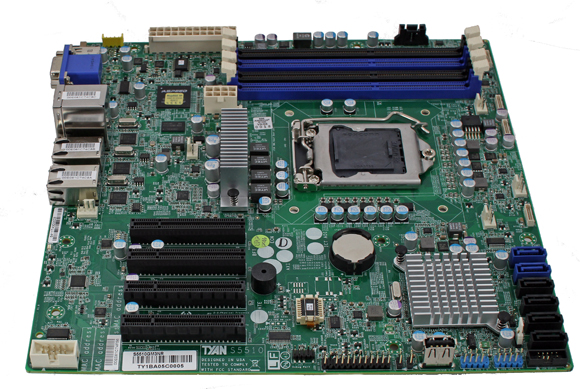
Like the Supermicro X9SCM-F, the Tyan S5510GM3NR has four physical PCIe x8 slots. Of these four slots, two are PCIe 2.0 x8 and the other two are PCIe 2.0 x4. Using this configuration I really like the setup. My only wish is that the board had PCIe x16 physical slots or four open ended x8 slots (top two are open ended) so that x16 cards could be used in every spot.
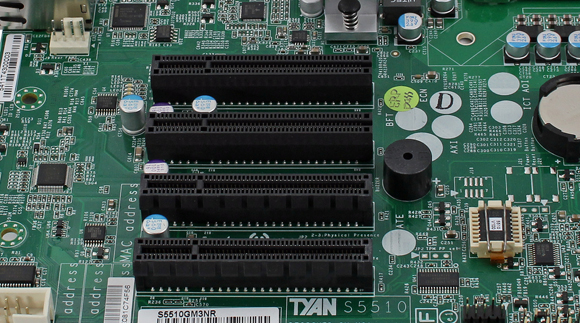
The socket H2 CPU area is clear from obstruction giving plenty of room for either the stock Intel heatsink-fan (HSF) or a passive cooler assuming the case has sufficient airflow. There are four DIMM slots that only accept unbuffered RAM (ECC or non-ECC.) As of the summer of 2011, it is difficult to find 8GB unbuffered DIMMs, making a practical limit to memory of about 16 GB.
Two SATA III 6.0gbps ports and four SATA II 3.0gbps ports that run perpendicular to the PCB’s plane and the SATA setup is standard on C204 boards. It should be noted that in the Intel Matrix RAID arrays one cannot mix drives from the SATA III and SATA II ports. Given that software RAID is very popular today, and the fact that PCIe SAS/SATA controllers are relatively inexpensive for eight ports, this is not a huge deal for most users. On the other hand, some folks prefer the C202 chipset if they want six 3.0gbps ports.
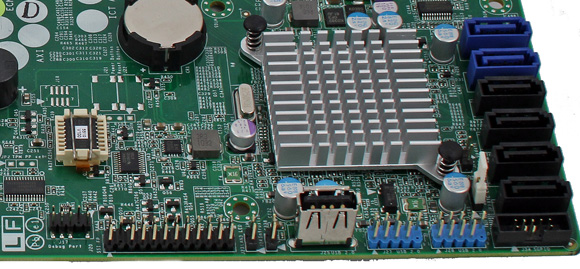
One will also notice that there is an internal USB header which again is almost a required server feature these days as it allows one to install a USB drive inside the chassis. With many storage operating systems such as unRAID requiring a USB key for licensing purposes, having an internal header is very handy.

The lack of PS/2 keyboard and mouse ports on the rear I/O panel is an interesting direction, albeit one that I am excited to see (there are PS/2 to USB converters readily available if one really needs legacy support.) Four USB ports can be found interspersed with the Intel based NICs. A VGA out and serial port come next followed by two additional Intel gigabit NICs. One key advantage of the Tyan S5510GM3NR over the Supermicro X9SCM-F is that the Tyan board has three Intel 82574L gigabit NICs which are probably the defacto standard NICs at this point for servers. Windows Server 2008 R2 (and derivatives such as Windows Home Server 2011), OpenSolaris/ Solaris Express, Linux, FreeBSD and VMware ESXi all support the Intel 82574L easily upon initial installation. This makes life very simple for those looking to build machines and if one wants, they can use the IPMI NIC for data making the board quite flexible.
Features
Tyan’s IPMI 2.0 interface will be fairly intuitive if one is accustomed to other modern KVM-over-IP implementations. One can either use external IPMI tools or navigate to a web based interface.
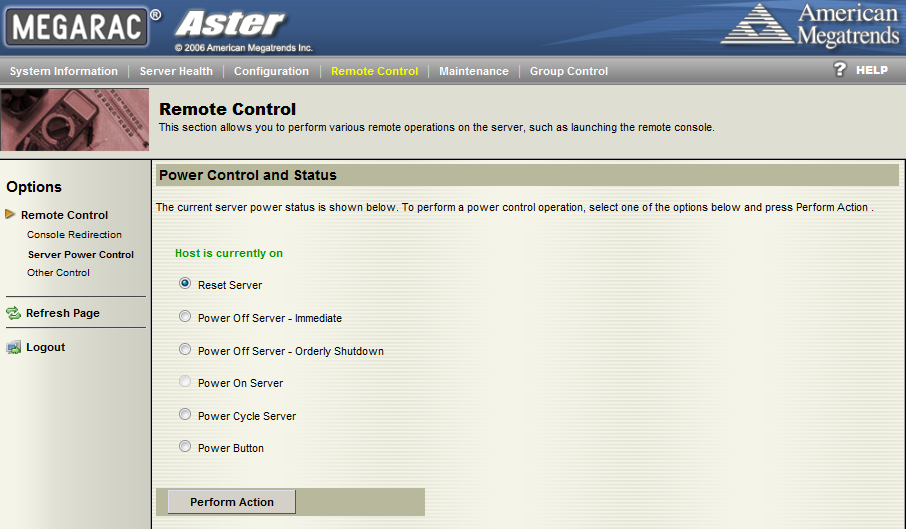
Users will find standard features such as the ability to control power functions of the server through the baseboard management controller and web interface along with standard features like remote monitoring of fans, temperatures and other sensors.
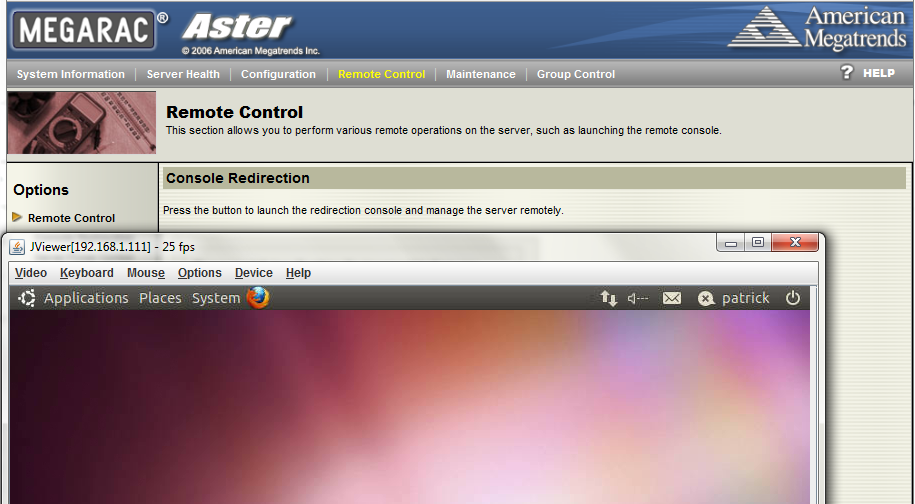
One of the most important features is the JAVA based KVM-over-IP functionality that allows a user to do several things. First, one can use a keyboard and mouse on a local machine to control the host. Second, one can remotely mount ISOs, local optical drives and etc. onto the server. These features are important to most users unless an external KVM-over-IP solution is used and one has a network switched power distribution unit (or multiple if a redundant PSU is used) that can power cycle a server.
Overall, Tyan provides the requisite remote management functionality to compete in the UP server market. To any potential buyer, I would strongly suggest getting a board with these features as they have become necessary management tools for machines not acting as primary workstations. In the near future Tyan’s remote management capabilities will be the subject of an in-depth piece on this site.
Conclusion
Probably the biggest selling point of the Tyan S5510 (S5510GM3NR) is the three integrated Intel 82574L NICs. This combined with built-in IPMI 2.0 and four x8 physical slots make it, perhaps, the strongest mATX server board available at the moment. I do like the Supermicro X9SCM-F IPMI implementation a bit better as Supermicro did customize things like being able to mount images from network shares directly through the WebGUI. On balance, the Tyan S5510GM3NR is a great board with tons of onboard features at a relatively low price. I was glad that Tyan allowed me to borrow the board for review as it is a solid board especially when the Tyan S5512WGM2NR is too large.
Feel free to discuss on the ServeTheHome.com Forums!

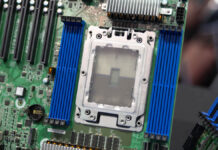
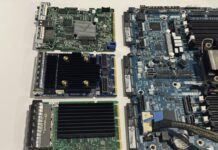
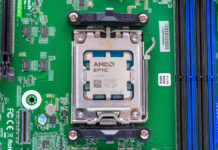
Great review, thank you!
Let me get the straight. You can use the IPMI NIC for both IPMI and network data, at the same time?
Regarding the lack of slots for x16 PCIe devices – to me it looks like the two top slots are indeed open ended, allowing for 2 x16 PCIe devices – can you confirm?
spazoid: You can, although using it simultaneously for data and IPMI has been problematic on my network. I will say that I typically let the IPMI NIC do only IPMI when I have that feature enabled because my network setup sees poor performance when the NIC does double duty and so I cannot recommend using them as IPMI 2.0 + 3 data NICs simultaneously. Others with experience with that setup may be able to point out the pitfalls. For me the IPMI NIC sits with other IPMI NICs on their own network that is solely used for management.
On the open ended slot thing, I clarified the language a bit as I was talking about the two bottom slots. Thanks for the catch.
Patrick,
Can you post the firmware versions you used — and comment on any differences from the firmware in the S5512WGM2NR review you did in April? Tyan recently posted 1.03 BIOS and 2.00 AST2150 (IPMI/iKVM) firmware for this board. I had some challenges with the 1.01 BIOS (which I worked around) – but have not been able to use the 1.03 BIOS since it cannot see all my existing drive partitions. I have NOT upgraded the AST2150 firmware yet.
Thanks!
SpeedyMe: I will look and see but I have not had the board in a few weeks :-/
Could you please tell me what board revision you have received from Tyan?
Thanks
Hi Patrick,
I just purchased a Tyan S5512WGM2NR and I am having a problem booting. I am using a Intel G530 cpu and some gskill 1600mhz ram. I changed the PSU to a antec and it boots ok so that i can log into the IPMI but no post. I can’t get into the bios at all. The Tyan’s website lists the CPU of being able to run.
Any suggestions?
Thx
JD
Sorry I meant the Tyan S5510GM3NR.
JD, did you try different RAM? I doubt that is the issue, but some server boards are a bit more picky than desktop counterparts. Also, you may want to try e-mailing Tyan tech support.
i actually have two questions that i can not seem to find answers on anywhere.
1st is has anyone actually gotten the power on through ipmi to work. i cant find much info on this nor have i found anyone that can get this to work.
2nd in the manual it stated sealed vs unsealed to tell true 8x slots vs 8x with only 4x lanes. I can not tell a difference on any of the 4 slots
any info on this would be greatly appreciated!